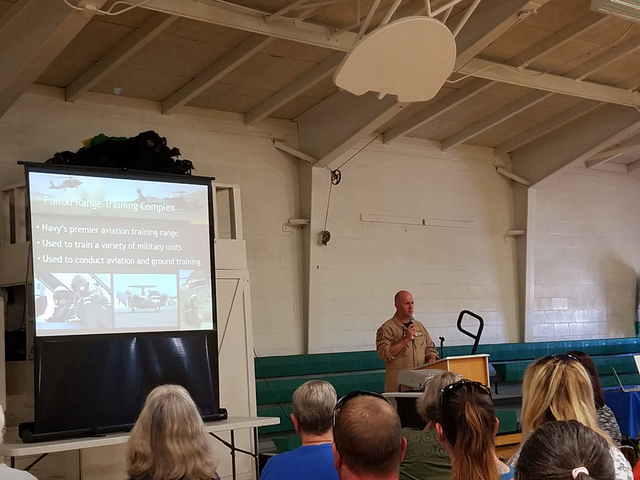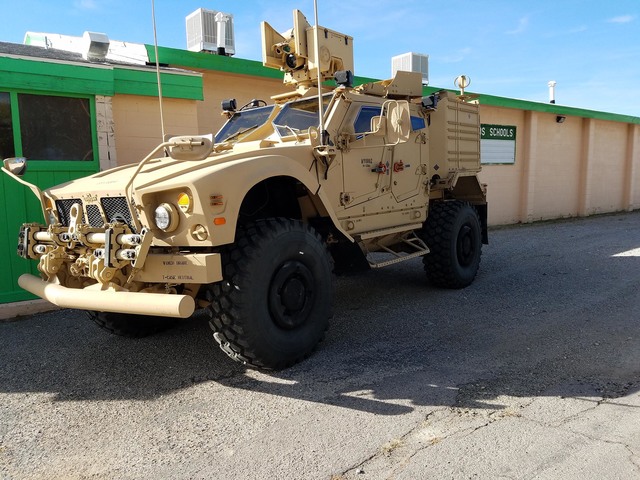Navy presses for expansion into northern Nye County
GABBS — Appearing before a crowd of at least 75, the commanding officer of Naval Air Station Fallon outlined the Navy’s proposed massive expansion of the Fallon Range Training Complex, growth that would extend into Nye County as part of the military’s aim to modernize.
The Navy seeks to renew its existing arrangement for 202,859 acres in addition to seeking for military use another 604,789 acres of public land to expand the current range. The Navy also wants to acquire another 65,160 acres of non-federal land.
“The Navy has looked at our training requirements and realized that we have outgrown the limits of our current construct at the Fallon range training complex,” Capt. David Halloran told audience members Oct. 7 at a public meeting in the Gabbs school gymnasium. “The bottom line is we don’t have enough room to actually operate in training the way that we have to train in combat.”
“My job is to make sure that naval aviators, when they go on deployment and go into combat, have seen the real-world type of activity that will happen when they are in combat…” he said.
The Navy is looking to make sure that when the U.S. “fights a near-peer competitor” the American “aviators have the best chance possible to be able to handle that threat and return back home,” Halloran said.
The meeting in Gabbs was one of seven in the region where the Navy’s plan was outlined.
Besides Halloran’s presentation, the event featured informal one-on-one questions and answers with Navy representatives who brought poster-like displays of the projects. Also available were videos and a court reporter who collected individual concerns or observations from residents.
The event did not feature a large-scale question and answer session, so no objections were voiced in a question and answer session. Concerns about issues such as grazing and access to public lands, however, were expressed to the Tonopah Times-Bonanza.
A decision on the Navy’s expansion proposal is not expected until around 2021, pending actions such as an environmental review, review of public comments, further public meetings and congressional action.
Though the Fallon range famous for its Top Gun school was not small 30 years ago, it now is considered small as the result of advances in technology and combat tactics.
Because of the constraints of the Fallon ranges, bombing is still practiced the way it was 20 or 30 years ago. But since then, officials said, combat tactics have changed due to enemies having better surface-to-air missile capabilities.
U.S. bombs that in the past were released at two miles from a target now are released at 10 to 15 miles away.
“We realized that the best way to keep our pilots safe was with altitude,” said Halloran, who flies F-18s.
“So instead of coming in low and bombing, he said, “I will now come in at 30,000 to 35,000 feet and launch my bomb to where it will carry somewhere between 10 and 15 miles, which gives me more distance away from the missiles that are firing at me and more altitude to be able to react to any missile that’s coming up to try and attack me….”
The changes, including the use of so-called “smart bombs,” means more land is needed to train.
“That is why we are looking for our ranges to expand some so that we have the ability to do the dynamic training,” Halloran said.
Currently, the training is occurring at about a 40 percent level of the Navy’s capabilities.
“We need to try to step it up,” said Halloran, who has been flying with the Navy for 23 years and trained at Fallon 10 times.
Fallon: ‘Carrier in the desert’
Naval Air Station Fallon is known as “the carrier in the desert” because of its role in training aviator crews who use American aircraft carriers around the world.
Officials describe the facility as unique.
“There’s a requirement for every airwing, a carrier-based pilot prior to deploying, to go through Naval Air Station Fallon within 90 days of the deployment to ensure that they’re at the highest level of training and readiness prior to pushing out on the boat,” Halloran said. “Once we push out on a boat, we never know what’s going to happen.”
“If something does go down, it’s that carrier that’s going to do it, whether it’s the Persian Gulf, Afghanistan or anywhere else in the world,” he said referring to potential military action and the role of U.S. aircraft carriers.
“What I’m trying to tell you is that our four bombing ranges at Fallon and the airspace that we have out here at the Fallon Range Training Complex, which is a about 100-mile-by-200-mile rectangle, is the only place in the world where we can do this training,” Halloran said.
Why Fallon?
Halloran often is asked why the Navy can’t use another location, such as Key West, Florida, over water “where you don’t bother anybody.”
“The problem is I can’t bomb the water,” Halloran said.
“There is just no legitimate target there, and in the water are whales, and now we hit the whales,” he said in describing potential scenarios. “I didn’t intend to kill the whale, but now I killed the whale. Why did I kill the whale? I don’t know. He was swimming in the wrong area so we don’t bomb in the water. I can’t get anything out of that.”
A target is available in the Key West area, but it’s on a small island.
“I can look out 60 miles ahead of me, and I can say, ‘there’s my target’ because there’s one little island. I know where the target is. I’m not getting much dynamic training because I already know where the target is. I can’t get spun around… I know where I’m going. It’s an easy target to hit.”
That is in contrast to Naval Air Station Fallon, where typically, “I have to hit one of seven buildings …I know I have to hit the southwest corner of the northeast building of this group of seven buildings.”
Precision is needed because the other buildings are considered collateral damage.
“I can’t do that when I’m going against the island in Key West, which is called the ‘Floating Tortilla’ because about 40 miles of it looks like a small tortilla, he said.
Other than Fallon, “I can’t do bombing anywhere else,” Halloran said, calling Fallon “doctorate level” training.
“The other bombing ranges that we have are not nearly to scale with what we have here…”
Halloran also is asked why Navy pilots can’t train at Nellis Air Force Base in the Las Vegas area.
“There’s not enough time in the year for the Air Force and the Navy to train on the same ranges,” he said. “If there was, we’d do it.”
In 2015 at Naval Air Station Fallon, only six weeks were free of training.
“Nellis had the same type of scenario,” Halloran said. “You can’t overlap.”
Contact reporter David Jacobs at djacobs@tonopahtimes.com


















